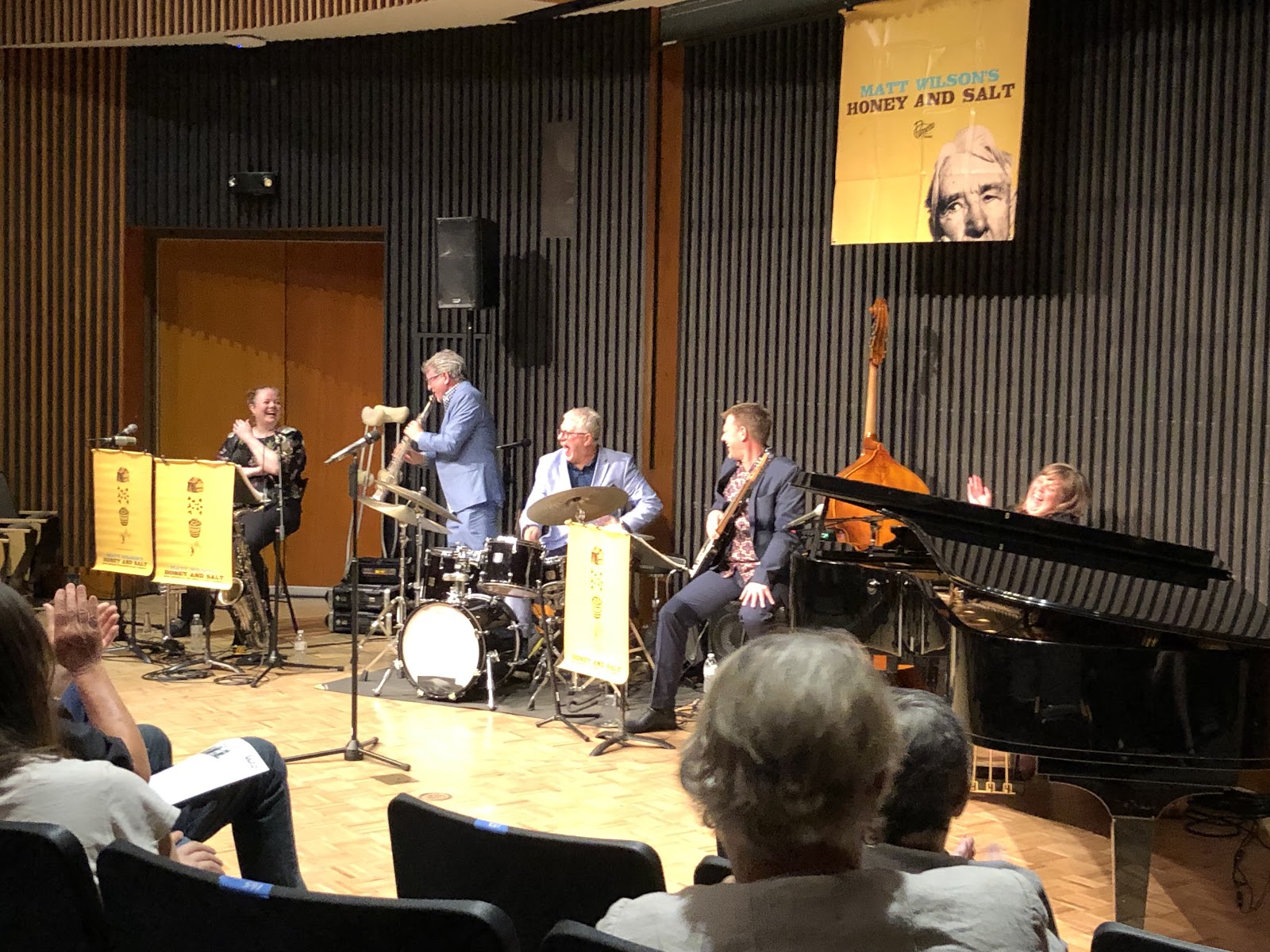Matt Wilson’s band performing their new album, “Honey and Salt,” superbly demonstrated the unique talents of each musician in songs like “Fog,” as well as their ability to cooperate through songs like “Choose.” The performance captured me with smooth delivery and sonic breakthroughs.
On July 14, my father and I, along with Jazz Camp members and other eager spectators, gathered at the Dinkelspiel Auditorium to see one of the most captivating performances of the year: Matt Wilson’s band performed Wilson’s new album, “Honey and Salt.” Featuring five gifted musicians — Wilson, the drummer; Dawn Clement, the pianist and vocalist; Jeff Lederer, the reed player; Nadje Noordhuis, the trumpet player and vocalist; and Martin Wind, the base player.
“It feels very different when you have lots of young students in the audience” Noordhuis told The Daily. “At that point I’m more aware that they are perhaps looking up at us the way that I would have looked up to performers when I was their age.”
“Honey and Salt,” Wilson’s 13th album, is an ingenious jazz reinterpretation of Carl Sandburg’s classic poems. Even though each track seemed casual and undirected on the surface, the songs told stories through a coalescence of instruments, verse readings and singing.
“I grew up in West Central Illinois, in the town adjacent to Mr. Sandburg’s.” Wilson told The Daily. “We studied his poetry at a very young age, and as I left home I rediscovered my roots and become even more appreciative of them.”
The first track on the album, “Soup”, gave me a taste of how poetic jazz can really be. As one of the more casual songs on the album, the song was performed with such an easygoing manner that I felt I could see the “famous man eating soup” in the poem as vividly as Carl Sandburg did.
“People just buy it, and they get into it.” Wind said.
The transition to the second track, “Anywhere and Everywhere People” was immediate. Clement’s singing of interesting words like “anywhere,” “everywhere” and “be seen,” on top of the already playful music, gave me the impression of studying an abstract modern painting.
The mood became more peaceful in songs “As Wave Follows Wave,” “Night Stuff,” “Fog” and “Prairie Barn.” One detail of the songs that enchanted me was the use of instruments and human vocals to simulate the sound of nature.
Toward the end of “As Wave Follows Wave,” each musician said “as wave follows wave” continuously with different volumes, pauses and tones to give the effect of waves splashing over the shore. The repetitive playing of Carl Sandburg reading the poem “Fog” as Wilson’s drum rhythms mimicked the imaginary movement of fog was quite original. Wilson’s slow shaking of the tambourine to create the effect of wind and bells in “Prairie Barn” is among the most creative techniques I have seen.
One of the best parts of the performance was the five musicians’ chorus of one of Carl Sandburg’s most renowned poems, “Choose”. The poem is about our attitudes towards dealing with everyone and everything in life, and whether we should treat them with an “open, asking hand,” or a “clenched fist.” Seeing jazz musicians interpret a 20th-century poem in a refreshing way, without sacrificing its original taste, is inspiring.
“I think an important part of the work is the range of the songs, range of the groove, range of the dynamic and range of the licks of the tunes,” Wilson said. “Sometimes people are surprised when we do some tracks that are really short, because they’re used to jazz songs being a certain amount of time.”
“Track 1” contrasted the rest of Wilson’s works, as he intended. With other tracks lasting an average of 3-4 minutes, this track was less than a minute. The audience got more excited when the performers invited an audience member to read the lyrics. This spontaneous connection between the audience and the performers was very memorable.
“This is an offering and receiving process,” Wilson said. “We’re offering sound, but at the same time, we’re receiving something back from the audiences. We’re receiving applause and smiles.”
Wilson likes to call the area between the concert hall stage and the first row of audiences the “moat.” And good musicians should be constantly thinking: How do we take away that moat and make the audience part of the music?
Throughout the performance, the musicians attempted to remove the metaphorical moat by interacting with the audience and “really allow the audience members into [their] world,” Wind said. Subtle details from Clement’s expression of lyrical emotion, to Wind’s exaggerated grooves, to Wilson’s passionate rhythms, and Lederer’s spontaneity playing reed all helped to remove that “moat” without us noticing. Their idea of making the members of the audience read poem verses while they perform also helped pull the audience into the story that the band was trying to tell.
“We’re really trying to bring as much joy to the audience as possible,” Noordhuis said. “We’re not trying to be serious and create a sort of studious atmosphere. It’s all about this freewheeling celebration of music and poetry.”
Contact Brian Lee at bl45983 ‘at’ pausd.us.
